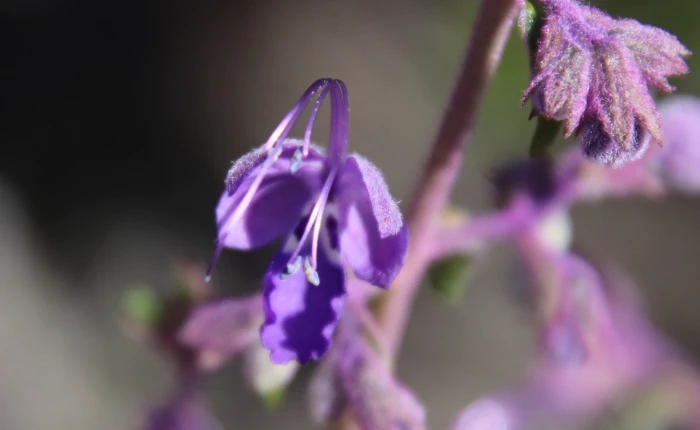Parish’s Bluecurls
(Trichostema parishii)
Parish’s Bluecurls (Trichostema parishii)
/
/

Millie Basden
CC BY 4.0
Image By:
Millie Basden
Recorded By:
Copyright:
CC BY 4.0
Copyright Notice:
Photo by: Millie Basden | License Type: CC BY 4.0 | License URL: http://creativecommons.org/licenses/by/4.0/ | Rights Holder: Millie Basden | Publisher: iNaturalist | Date Created: 2019-04-25T08:00:10-07:00 |










































Estimated Native Range
Climate Requirements for Plainfield, Indiana
| This Plant | Your Site | Plant Suitability for Your Location | ||
|---|---|---|---|---|
| • Precipitation | 7" - 37" | 41" | Aquatic | Aquatic |
| • High Temp. | 77°F - 104°F | 86°F | Your summer temperatures are normal for this plant. | Excellent |
| • Low Temp. | 23°F - 46°F | 17°F | Your winter temperatures may be too cold for this plant | Too cold |
This plant may not grow well at your location - your precipitation is too high.
Summary
Trichostema parishii, commonly known as Parish’s bluecurls, is a perennial herb in the mint family, Lamiaceae. This species is native to the chaparral and coastal sage scrub of southern California and northern Baja California, where it thrives in dry, open areas. It typically grows to a height of approximately 12 decimetres (3.9 feet) and is characterized by its aromatic herbage, which is coated in short glandular and nonglandular hairs. The plant’s most striking feature is its inflorescence, a long cyme of flowers that emerge from the stem between each leaf pair. These blooms are coated in fluffy, woolly hairs and display vibrant shades of blue, pink, and purple, making them quite showy during the flowering period from March to May.
Parish’s bluecurls is valued for its drought tolerance and the unique, colorful appearance of its flowers, which can add a touch of whimsy to rock gardens, native plant gardens, and dry landscapes. It is also appreciated by pollinators, particularly bees, which are attracted to its flowers. In cultivation, it requires full sun exposure and well-draining soil, preferring low amounts of water once established, which makes it suitable for xeriscaping. While it is generally low-maintenance, it can be susceptible to root rot if overwatered or planted in poorly draining soils.CC BY-SA 4.0
Parish’s bluecurls is valued for its drought tolerance and the unique, colorful appearance of its flowers, which can add a touch of whimsy to rock gardens, native plant gardens, and dry landscapes. It is also appreciated by pollinators, particularly bees, which are attracted to its flowers. In cultivation, it requires full sun exposure and well-draining soil, preferring low amounts of water once established, which makes it suitable for xeriscaping. While it is generally low-maintenance, it can be susceptible to root rot if overwatered or planted in poorly draining soils.CC BY-SA 4.0
Plant Description
- Plant Type: Subshrub, Shrub
- Height: 1-3 feet
- Width: 3-6 feet
- Growth Rate: Moderate
- Flower Color: Blue, Purple
- Flowering Season: Spring, Summer
- Leaf Retention: Evergreen
Growth Requirements
- Sun: Full Sun
- Water: Low
- Drainage: Medium, Fast
Common Uses
Bee Garden, Bird Garden, Butterfly Garden, Deer Resistant, Drought Tolerant, Fragrant, Hummingbird Garden, Low Maintenance
Natural Habitat
Native to chaparral and coastal sage scrub of southern California and northern Baja California
Other Names
Common Names:
Scientific Names: Trichostema parishii
GBIF Accepted Name: Trichostema parishii Vasey